While propane is considered a “cleaner” fuel than gas or coal, it’s often sourced through destructive environmental practices. Here are our top picks for energy efficient outdoor heaters that won’t degrade air quality, and that don’t burn fossil fuels.
Table of Contents
As the weather starts to turn chilly, you may not be ready to give up on outdoor entertaining. Patio heaters seem to offer the solution. Popular throughout the American Sun Belt and other regions with relatively mild temperatures, outdoor heaters can take the edge off cold weather and keep the party going past the point when you would otherwise head indoors.
There’s a lot to consider when deciding what kind of patio heater to buy—not the least of which is its environmental impact. Here’s a closer look at what these outdoor heaters really mean for the planet and our choices for the best energy-efficient patio heaters available.
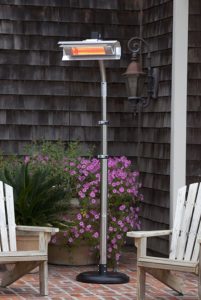
Best electric patio heater
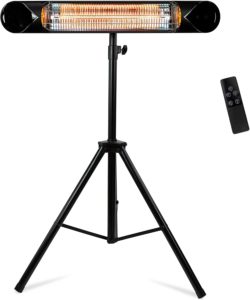
Best multi-functional outdoor heater
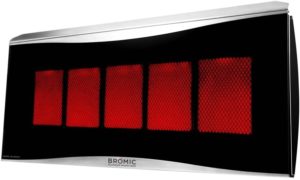
Best mounted outdoor heater
Bromic Heating BH0110003-1 Smart-Heat Platinum 500 Radiant Infrared Patio Heater
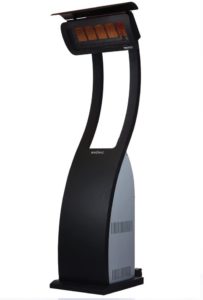
Best heat-focusing outdoor heater
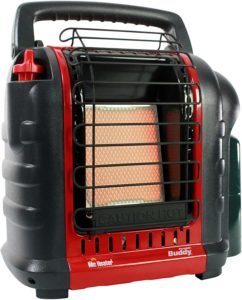
Best small outdoor heater

Heat-focusing outdoor heater runner up
Patio Heater Energy Efficiency: Propane or Electric?
Propane is a standard choice for outdoor heaters. As a natural by-product of petroleum refining and natural gas extraction, propane has a higher heat content than natural gas, meaning you need to burn less to achieve the same amount of heat. So, while propane is considered a “cleaner” fuel than gas or coal, it’s often sourced through destructive environmental practices like fracking and underwater oil drilling.
Propane heaters tend to produce more heat than electric ones because they aren’t limited to your home’s circuit system. But on the flip side, this means they have fewer safety features because they won’t shut off if the circuit becomes overloaded.
Most propane heaters are compatible with 15- to 20-lb propane tanks, although portable models go as small as 1-lb. The amount of fuel you will go through depends on the heat setting and surrounding air temperature, but plan to burn more the colder it gets.
Electric heaters run off your home’s energy grid. Not only does that leave you without the task of refilling empty propane tanks, but it offers the opportunity to tap into renewable energy if that’s what powers your home.
This makes electric heaters both cheaper and safer to use than propane. What you give up for that convenience is heat, as they don’t tend to get as warm or heat as large of an area. In fact, most electric heaters max out around 5,100 Btus.
Is electric heat better for the environment than propane? This question doesn’t have a simple answer. When used for outdoor heaters, propane gets much hotter than electric heat, meaning you need to use less energy to achieve desired temperatures.
On the flip side, it’s possible to power electric heaters off renewable energy sources like wind or solar. But, if you’re relying on nonrenewable sources for your home’s electricity, you’ll still produce a significant carbon footprint with an electric heater.
Understanding Infrared vs. Forced Air Heat
Most outdoor heaters produce infrared heat. Ideal for windy conditions, infrared heat warms only what it comes in direct contact with. This leads to a far more efficient form of heat because it doesn’t get dispersed in the ambient air. The drawback is you’ll only feel warm where the heat touches you directly. On an outdoor patio, this can lead to a warm face but freezing hands and feet.
In contrast, some heaters provide forced air heat. Like an indoor furnace, it warms the air immediately around it, meaning the heat can be easily lost with any amount of wind. In most cases, forced air heaters only make sense on calm days when you can direct the hot air in specific directions—otherwise, they are a massive waste of energy.
How to Choose the Best Patio Heater for You
Outdoor heaters can be a bit of an investment, so you’ll want to make sure you’re buying the right one; here are some factors you should consider when deciding on a patio heater.
What’s the space like?
It’s important to scale your patio heater to the space it needs to warm. A small porch won’t need a powerful heater, but a larger patio may be better served with a bigger unit or even two or three spaced throughout. Measure the square footage you’re working with, so you know how far the heat needs to reach.
What’s the maximum Btus?
British Thermal Units is the formal measurement for heating appliances. The higher the number, the more heat produced, but the larger the fuel requirement. One way to estimate the Btu you need is to multiply the cubic footage of your space by the desired increase in temperature.
What type of heater do you want?
Portable patio heaters come in multiple styles:
- Freestanding – these include a base, heat reflector, and fuel source. They are the most popular option for large outdoor spaces.
- Mounted – Designed for permanent installation in your outdoor space, mounted heaters offer discrete warmth.
- Tabletop – Small and usually electric, tabletop heaters provide warmth for an intimate gathering and often feature unique design elements.
What are the safety features?
For those with kids (and even crazy pets), safety needs to be a top concern with outdoor heaters. Seek out models that have automatic shutoff valves, cool touch glass, and protection against tipping over.
The best energy-efficient outdoor heaters: our top picks
Without further delay, let’s look at our top choices for energy-efficient patio heaters this year.

Best Overall Electric Patio Heater: Fire Sense Telescoping 1500W Electric Infrared Patio Heater
Highlights: Simple and straightforward to use, this electric heater will warm a small gathering fast without taking a toll on the environment.
- Type: freestanding, infrared
- Total BTUs: 5,500
- Fuel Type: electric
- Heating Area: 120 square feet
- Weight: 45 lbs
Small but mighty, this telescoping outdoor heater puts out impressive warmth, considering its operational capacity of 5,500 Btus. It comes with a 1500-watt bulb that lasts up to 5,000 hours.
Operating at an impressive 90 percent heating efficiency, you’ll waste little energy using this heater outdoors—guaranteeing guilt-free outdoor gatherings. Even rain won’t pose a problem, as its durable design is entirely weather resistant.
You’ll start to feel its heat within a few seconds of turning it on, and it can keep everyone warm within a nine-foot diameter.
Best of all, the heavy-duty stainless-steel frame comes with wheels, tip-over protection, and a heating head that can pivot easily to better direct the heat where you want it.

Best Multi-functional Outdoor Patio Heater: Briza Infrared Patio Heater
Highlights: If you can’t quite envision how an outdoor heater will work in your space, this Briza heater gives you the option to keep it at shoulder height or mount it to your wall.
- Type: tripod or mounted, Infrared
- Total BTUs: 5,115
- Fuel Type: electric
- Heating Area: 100 square feet
- Weight: 17 lbs
Not sure how best to heat your space? With this Briza infrared heater, you can switch between the convenience of portability with a tripod stand or mount the model on your wall or ceiling for hassle-free heating that’s entirely out of the way.
This dual-use heater comes with the hardware for either option, as well as a remote for powering the heater on and off from afar. You can adjust the infrared heat from 900w to 1200w or 1500w to ensure you get the precise amount of warmth necessary for your space.
Even so, you can relax knowing it operates at 93% heating efficiency.
There’s no reason to worry about run time, as the build-in timer can shut it off after however many hours you pre-set through the remote. And with an IP 55 rating, the Briza can operate smoothly in all elements, making it a viable heating strategy even in the midst of snowfall.

Best Mounted Heater: Bromic Heating BH0110003-1 Smart-Heat Platinum 500 Radiant Infrared Patio Heater
Highlights: Enjoy discrete heating that doesn’t distract from the party with this wall or ceiling-mounted heater that puts out serious warmth fast.
- Type: Wall-mounted
- Total BTUs: 39,800
- Fuel Type: propane/ natural gas
- Heating Area: 200 square feet
- Weight: 40lbs
For those looking to buy one patio heater to beat them all, it’s hard to go wrong with this infrared heater from Bromic. It’s meant to be mounted permanently to an outdoor wall or ceiling to serve as a discrete heating source that doesn’t take up valuable square footage in your entertaining space.
Small as it seems, this powerful heater puts out enough warmth to keep up to 200 square feet warm. But worry not—the slow-release ceramic burners make it more environmentally friendly than comparable heaters.
It also offers ionization probe technology to keep you warm despite winds up to 12 mph.
Note that professional installation may be required for this model.

Best Heat-Focusing Heater: Bromic Heating Portable 38500 BTU Patio Heater
Highlights: Enjoy the advantages of infrared heat with this powerful propane heater guaranteed to keep the whole party warm without wasting heat where you don’t want it.
- Type: freestanding, radiant infrared
- Total BTUs: 38,500
- Fuel Type: propane
- Heating Area: 180 square feet
- Weight: 22 lbs
If price isn’t a concern, you can’t go wrong with this infrared heater from Bromic. It boasts an impressive 38,500 Btus at maximum capacity and can heat 180 square feet of outdoor space.
The heating head design lets you direct heat precisely where you want it to ensure none is wasted where people aren’t sitting.
Another selling feature for many is its eye-catching design. This modern heater won’t look out of place with the chicest patio furniture, ensuring that it brings the aesthetics of your entertainment space up a notch.
This premium heater runs on a 20 or 30-lb propane tank (not included) and can operate in winds up to 7.5 miles an hour, which the company claims is more than twice its competitors.
Standard safety features like a gas flow shutoff if the flame goes out or the heater tips ensure you can use it stress-free.

Best Small Outdoor Heater: Mr. Heater MH9BX Portable Buddy Heater
Highlights: Lightweight and travel-friendly, this Portable Buddy Heater will warm you in a pinch. Just don’t expect it to have enough heating capacity to keep a large party going.
- Type: Portable, infrared
- Total BTUs: 9,000
- Fuel Type: propane
- Heating Area: 225 square feet
- Weight: 8.5 lbs
If your outdoor heating solution needs to work as well on a camping trip as it does in your backyard, then there’s good reason to consider the Portable Buddy Heater from Mr. Heater.
Considered one of the best brands for off-grid outdoor heat, it’s the perfect size to warm four to five people sitting close.
This lightweight heater includes a carrying handle and is safe for indoor use, such as in a tent. You’ll power it off one-pound canisters, each of which can last for three hours on the highest setting.
As with most outdoor heaters, it comes with an automatic safety shutoff function in case it tips over, as well as an oxygen depletion sensor.

Heat-Focusing Heater Runner Up: Hampton Bay Heat-Focusing Propane Gas Patio Heater
Highlights: While it’s a forced-air heater, Hampton Bay’s Heat-Focusing patio heater is still a smart choice if you know where to direct it.
- Type: Free-standing, forced air
- Total BTUs: 38,200
- Fuel Type: propane
- Heating Area: 120 square feet
- Weight: 81 lbs
Forced air heaters tend to be a poor choice outdoors if you’re concerned about conservation, but this model from Hampton Bay still makes our list thanks to its heat-focusing reflectors.
By angling the reflectors found on the top, you can concentrate all the warmth in one direction for maximum heating.
It’s powerful enough to heat 120 square feet of patio space and comes with a high-quality powder coating for durability despite the elements. The weighted base adds stability, and it comes with wheels for easy navigation.
Safety-wise, the heater’s anti-tilt design, and flame failure cut-off ensure it won’t run when it shouldn’t.
Note: Propane tank not included.
The Environmental Impact of Outdoor Heaters
Let’s not pretend otherwise—it’s a strange proposition to heat outdoor air using fossil fuels that are responsible for accelerating global warming in the first place. Outdoor patio heaters are notoriously inefficient and are fast becoming controversial. Many countries, including France, have even banned their use in outdoor restaurants.
While skipping the heater altogether is clearly the most sustainable choice, there are options to use these heaters sensibly. Choosing the smallest size that will work for your space, refraining from using it when you’re not right near it, and bundling up with extra clothing and blankets will all help you to stay warm without burning fossil fuels.
How Can I Make an Outside Heater More Effective?
Getting the right outdoor patio heater is only part of the battle of staying warm during wintry months. Even the best options listed here may make only a marginal difference if you don’t take additional steps to ensure your space stays comfortable.
By far, the best step you can take for outdoor warmth is blocking the wind. Pay attention to the direction it blows through your property so you can set up windbreaks whenever possible. Even a tarp spread out between two trees can make a significant difference in wind chill, and you can dress it up with solar-powered strung lights (View on Amazon).
Heat rises, so consider creating a protective roof around your space to keep the warmth near your company. Gazebos, awnings, and even open umbrellas can all do the trick. Note: this won’t work for infrared heat.
Finally, the age-old trick for staying warm in the cold still applies here—put on more layers! Filling your outdoor space with a few cozy blankets (preferably down comforters) will also make a world of difference for keeping everyone cozy.
So long as you consider patio heaters as a supplemental form of heat after taking other measures to stay warm and commit to using them in an environmentally responsible manner, they can be a viable way to enjoy more time outdoors this winter.